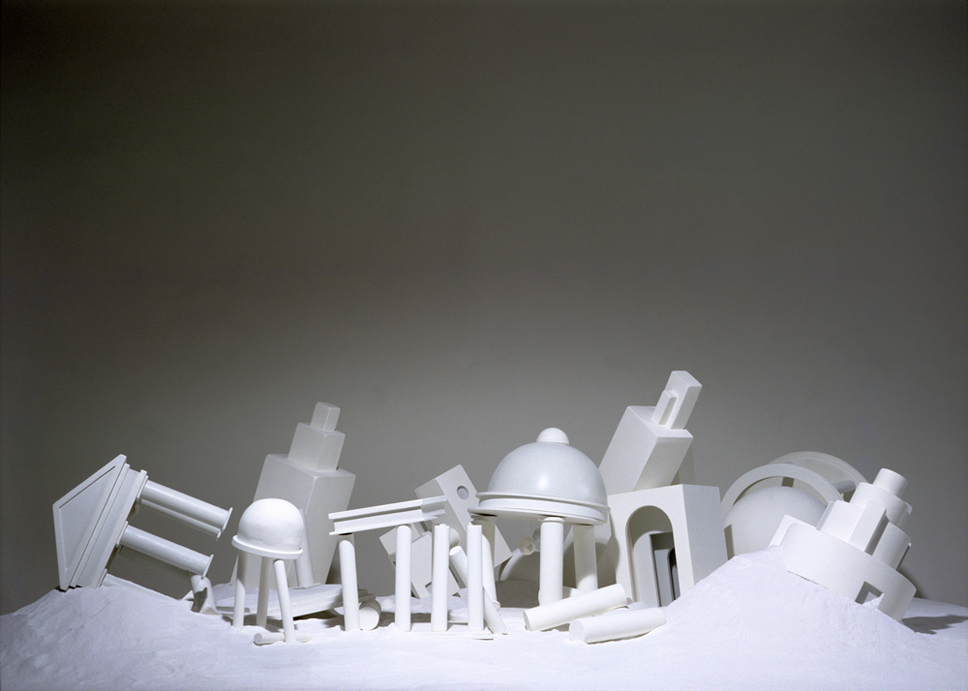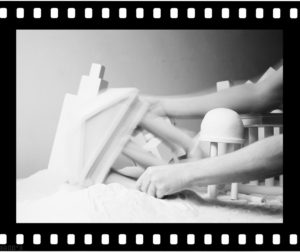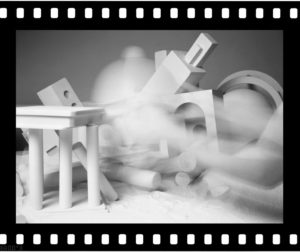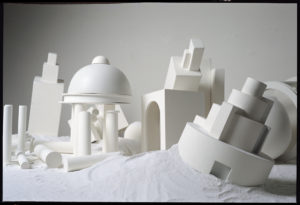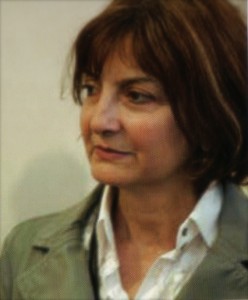A Window on Utopia
Irma Arestizabal
“Utopia is always on the horizon –say Fernando Birri. I draw two steps closer, and it moves two steps back. I take ten steps and the horizon slips ten steps further away. However far I walk on, I will never reach it. What purpose does it serve? Its purpose is this – to make us walk on”.
Eduardo Galeano
For some time Inés Fontenla has been pondering in her work on continents which no longer exist, on idealised cities, on faraway and little known lands. Her works propose a consideration of the ways of depicting the space we inhabit, they speak of the nature of the image and question the representation of reality. In this installation which she presents in the University of Rome, Fontenla points out the frailty of utopias, a fragility caused , above all, by the fact that in all cases the image of the hoped – for future is in contrast with the present state as with its direct opposite, but no attempt is made to show how it is possible to move from one to the other.
Is it possible to achieve a perfect state in an imperfect world? Fontenla thinks that utopias can fall apart as thoughts do. In presenting each of her utopian proposals as ruins, or constructions of sand, she provokes a disturbing sense of unease in the onlooker . ”All utopias share common features. They offer the detailed image of a complete society, closed in on itself (which is why they are often located on islands or planets, or projected into a distant future) and they veil a critical attitude towards existing society” (1) This explains why many have looked to the far side of the Atlantic in their conception, in order to begin afresh.
The architects of the Renaissance, on the other hand, sought inspiration in the classical theories of proportion and in classical city planimetry in designing their ideal cities in Europe. (2) Think, for example, of the “Pienza” that Bernadino Rossellino built on the original Cosignano, in memory of Pope Pius 11; the “Sforzinda”, that Filarete ( Antonio Averulino) designs in 1490 for Ludovico Sforza, a city conceived in the shape of a star, traced by the high fortified walls and with a central tower that enabled the sighting of
enemies “ from
without” and “from within” (external and internal). Or the formidable nonagon of Palmanova, the starred city whose building was begun in 1593 on the site chosen by the Inspectors General of the City of Venice; (3) the crossroads between Giulia Augusta and the Via Ungaresca according to the plan drawn up by a group of engineers, theoricians and experts in military architecture who were working in the Ufficio di fortifications di Venezia, as commissioned by Giulio Savognan.
Upon a white circle, an island created in the centre of the room, Fontenla gathers the models of the utopian buildings .She is referring to a centuries old conceptual bond (1) ,
that of the island utopia . (4) The island , geographically apt , a land apart in which we feel protected, uncontaminated space, great emptiness, refuge, pure possibility; in short the ideal place in which to build utopia. A model which oscillates between the religious and the political, to which existing societies can compare themselves in order to quantify the good and evil they themselves contain.
An island which, as in the double meaning of he Greek root of the name utopia, is both
“good place” and “no place“. A word that denotes that which is in no place, or ,as affirms
- Berthelot, not only that which has never been created anywhere, but also that which could never be created in its whole. Utopia is nowhere, it is only project, possible future, the dream of a society in harmony and happy, in short, perfect.
On the white circle the white monuments fall in ruins to the ground, like the buildings depicted in the wonderful Hall of the Giants in the Palazzo del Te by Giulio Romano, which crush beneath them the giants who attempt to reach Olympus. Broken columns that no longer hold up the domes and the frontals that crowned them.
In the video which is part of the exhibition, the artist tells of the persistence of the utopian idea throughout history. In a white space, white hands on a white background ( infinite, timeless, as is the gold background of Byzantine mosaics) try in vain to reconstruct the architecture.
Although the term utopia cannot properly be applied to an ideal society before its invention by Thomas More, the imagining of the concept of utopia seems to be immanent to man: aware of this fact, Fontenla uses various paradigmatic examples taken from the history of our culture in the conception of her work. Just as in other works she looked at the science of mapmaking and geological studies which tell us of changes, fractures, cataclysms, here she patiently follows the story of utopias throughout the centuries: Atlantis, sunk in the ocean and so invisible, and the Republic of Plato (5) which would later inspire the Utopia of Thomas More, who describes in his “De optimo reipublicae statu, de que nova insula Utopia “ (1516) an imaginary land, situated in the Americas, where lives a people perfectly wise, powerful and happy. No-one aspires to anything, since everyone has all he needs in abundance, thanks to the ideal institutions they enjoy; La città del sole of Tommaso Campanella (1623) where the Genoese navigator who has travelled around the world and visited the lands of Tropobana ( drawn on mediaeval maps to the West of Europe, in the middle of the ocean where later would be discovered America) tells that the island is governed by the supreme head Sol, assisted by Pon, Sin, and Mor, three princes whose names mean Potere ( Power) , Sapienza (Wisdom), and Amore (Love); La Salento described in the Télémaque of Fenelon, the phalanstery conceived by Charles Fourier, or the imaginary city where all live harmoniously together described by Etienne Cabet in Voyage en Icarie (1880) In all these works the persistence of the concept of utopias
through history is clear.
Finally, the didactic intention of these works is no other than to show a model of society that might work like the Platonic ideal, like a “should be” that might direct real society.
That is what happened in Brazil when a group of Frenchmen crossed the Atlantic in order to realize the utopia of Fourier, with the foundation, at the beginning of the 1840s , of two phalansterian colonies (Sai and Palmital) (6) opposite the island of San Francisco, at the extreme North – West of the state of Santa Caterina.
“ What can we do now, after the disappearance of the utopian ideal, after the hedonistic orgies of the 80s, in a world without gods, without real meaning, with no point of reference, populated, more than anything else, by images and specifically technological images?” (7)
Our artist has decided to use art as the form or perspective within our consciousness , and in commenting with her work on so many dreams of perfection and plans for a happy life, she is saying, with Eduardo Galeano, that what is important in the end is to learn to walk.
Irma Arestizabal
For my son Antonio
Translation by Sandra Hancock
- Graciela Scheines, Las metàforas del fracaso, Buenos Aires, Ed. Sudamericana, 1993.
- For Vitruvio, a city designed in relation to the human body would mirror human beauty, and the beauty of agriculture would inspire virtue in its citizens.
- In the disputed territory of Friuli – Venezia Giulia.
- On this theme see: May Lorenzo Alcalà, Islario, Buenos Aires, Ed. Sudamericana, 1997
- Plato, in Repubblica 1X, 591 B. “Perhaps an example of this city of ours exists in the heavens, and it is not important whether it really exists somewhere, or even that it should exist: it is an example for anyone to aim at who wants in the first instance to found such a place within himself”.
- As May Lorenzo Alcalà points out, Brazil and the United States are the countries of the Americas that have seen the greatest number of utopian experiments. In the United States in the wake of the utopian characteristics of the Protestant colonization, while in Brazil they gain strength from the fascination of the geographical exoticism of the country.
Benoit Mure, the” governor” of the Fourists, chose territories that were difficult of access. In fact, the Saby Peninsular is located on the continent, but it is so difficult to reach that it is necessary to go to the island and then cross the sea to gain entrance to it . - Cecilia Casorati, Terra Incognita, Rome 1997



